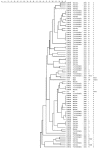Different clonal complexes of methicillin-resistant Staphylococcus aureus are disseminated in the Euregio Meuse-Rhine region
- PMID: 16189107
- PMCID: PMC1251497
- DOI: 10.1128/AAC.49.10.4263-4271.2005
Different clonal complexes of methicillin-resistant Staphylococcus aureus are disseminated in the Euregio Meuse-Rhine region
Abstract
The Euregio Meuse-Rhine (EMR) is formed by the border regions of Belgium, Germany, and The Netherlands. Cross-border health care requires infection control measures, in particular since the prevalence of methicillin-resistant Staphylococcus aureus (MRSA) differs among the three countries. To investigate the dissemination of MRSA in the EMR, 152 MRSA isolates were characterized by pulsed-field gel electrophoresis (PFGE), SCCmec typing, and multilocus sequence typing. PFGE revealed major clonal groups A, G, L, and Q, suggesting dissemination of MRSA in the EMR. Group A harbored mainly SCCmec type III and sequence types (STs) 239 and 241. The majority of the strains from group G harbored SCCmec type I and ST8 and ST247, whereas most strains from group L carried either SCCmec type IV or type I. Within group L, ST8 and ST228 were found, belonging to clonal complexes 8 and 5, respectively. Most strains from group Q included SCCmec type II and were sequence typed as ST225. Both ST225-MRSA-II and ST241-MRSA-III were novel findings in Germany. In addition, the SCCmec type of two isolates has not been described previously. One strain was classified as SCCmec type III but harbored the pls gene and the dcs region. Another strain was characterized as SCCmec type IV but lacked the dcs region. In addition, one isolate harbored both SCCmec type V and Panton-Valentine leukocidin. Finally, the SCCmec type of the strains was found to be correlated with the antibiotic susceptibility pattern.
Figures




References
-
- Aires de Sousa, M., and H. de Lencastre. 2004. Bridges from hospitals to the laboratory: genetic portraits of methicillin-resistant Staphylococcus aureus clones. FEMS Immunol. Med. Microbiol. 40:101-111. - PubMed
-
- Berger-Bächi, B., and S. Rohrer. 2002. Factors influencing methicillin resistance in staphylococci. Arch. Microbiol. 178:165-171. - PubMed
-
- Coombs, G. W., G. R. Nimmo, J. M. Bell, F. Huygens, F. G. O'Brien, M. J. Malkowski, J. C. Pearson, A. J. Stephens, P. M. Giffard, and Australian Group for Antimicrobial Resistance. 2004. Genetic diversity among community methicillin-resistant Staphylococcus aureus strains causing outpatient infections in Australia. J. Clin. Microbiol. 42:4735-4743. - PMC - PubMed
Publication types
MeSH terms
LinkOut - more resources
Full Text Sources
Medical

